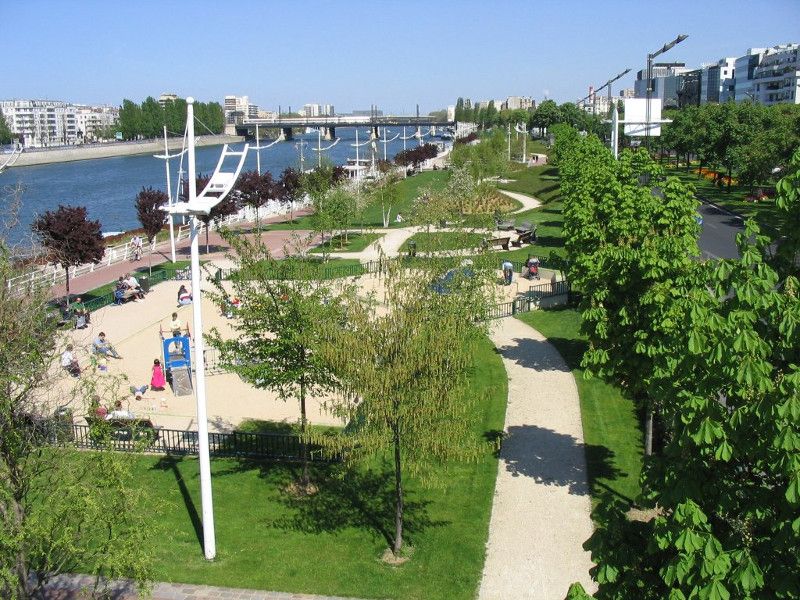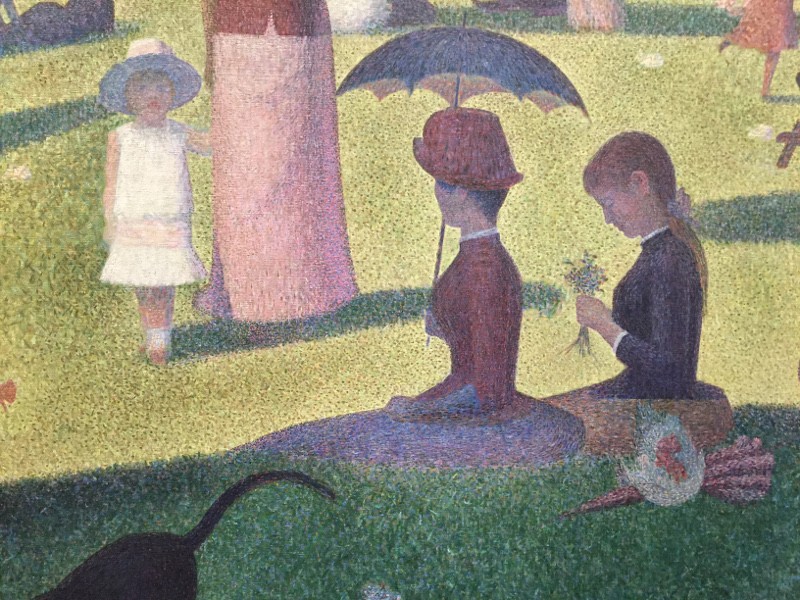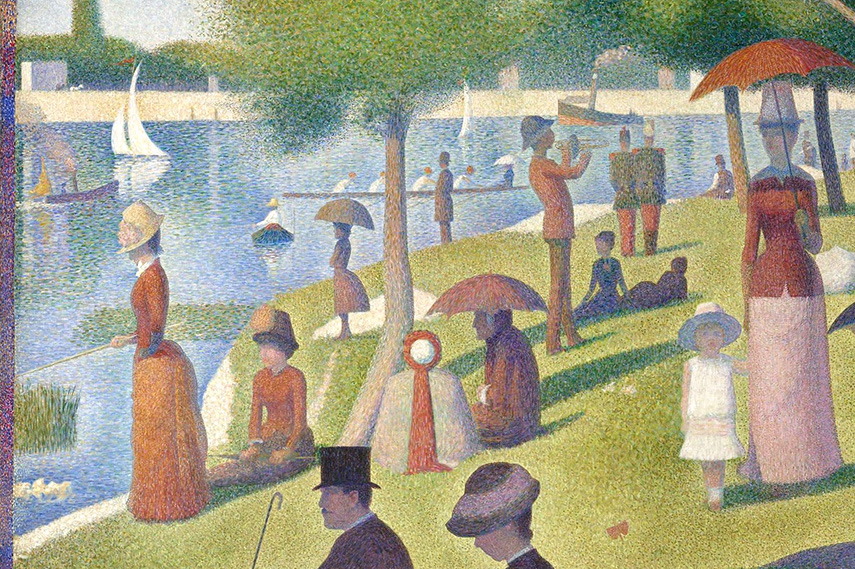Georges Seurat Believed That Art Could Be Created by a System of Rules
A Lord's day Afternoon on the Island of La Grande Jatte is both the best-known and largest painting Georges Seurat ever created on a canvas. It depicts people relaxing in a suburban park on an island in the Seine River chosen La Grande Jatte, a popular retreat for the middle and upper class of Paris in the 19th century.
A Sunday Afternoon on the Island of La Grande Jatte is 1 of those rare cases where a unmarried artwork is able to stand out completely - its transcendence, both narratively and technically, is instinctively recognized by everyone.
What makes this painting even more unique and mysterious is that the theme of the work is non some profound emotion or momentous event, only the banalest of workaday scenes.
Executed on a large canvas painted in 1884, A Lord's day Afternoon on the Island of La Grande Jatte reveals everything magical about Seurat'due south globe - information technology's beautiful and disturbing, sunlit and adumbral, silent and noisy, all at the same fourth dimension. The painting'south dimensions are approximately ii by 3 meters (7 by ten feet), representing a truly huge size for pieces painted during this period.
Georges Seurat Video - A Sunday on La Grande Jatte (1884-1886)
The Story Behind the Painting
When he painted this work, Georges Seurat was a mere 25-year-old who had only 7 more years to live. He was an aggressive boyfriend with a scientific theory to bear witness, something totally unique for the aristocracy of the mod fine art world. Seurat's theory was an optical one - he had the confidence that painting in dots was able to produce a brighter color than painting in strokes.
A Sunday Afternoon on the Island of La Grande Jatte was painted in two sessions, the first betwixt May 1884 and March 1885, and the second from October 1885 to May 1886. Seurat claimed he sabbatum in the park for hours upon hours, creating numerous sketches of the various figures in lodge to perfect their form before he even idea about starting the bodily painting.
Extremely disciplined and private to the indicate of almost complete secretiveness, Georges Seurat concentrated primarily on issues of color, light and form. Gustave Kahn often spoke most how Georges used the Panathenaic procession in the Parthenon frieze equally the principal visual model for this piece of work - yet, in that location was non a lot of classical in the completed painting.
Seurat's A Dominicus Afternoon on the Island of La Grande Jatte was one of the stand-out works in the eighth and concluding Impressionist exhibition in 1884. When it was shown at the Sociéte des Artistes Indépendents [one] during the aforementioned year, information technology encouraged critic Félix Fénéon to invent the name Neo-Impressionism, a term that eventually became the name of one of the greatest movements in mod art[ii].

Art of Pointillism - The Dotted Technique of A Sun Afternoon on the Island of La Grande Jatte
A Sunday Afternoon on the Isle of La Grande Jatte was initially started in 1884 with a layer of small horizontal brushstrokes of complementary colors. Seurat later added small dots that announced as solid and luminous forms when seen from a long enough altitude. This was the way he spectacularly proved his theory, showing that employing tiny juxtaposed dots of multi-colored paint really can allow the viewer's eye to alloy colors optically. This turned out to be a revolutionary culling to the style traditional painters went virtually defining forms within their artworks' compositions.
Seurat's use of this highly systematic and nearly-scientific technique[3] distinguished his art from the endlessly more intuitive approach to painting used past the Impressionists. Georges may have embraced the subject affair of modern life preferred by artists such equally Claude Monet and Pierre-Auguste Renoir, just the manner he depicted it on sheet couldn't exist whatsoever more unlike from the techniques of his peers.
Georges' technique was afterwards called Pointillism and it's known by that name to this twenty-four hour period. However, the painter himself preferred to call his method chromoluminarism, a term he felt better stressed the focus on color and light.

The Apparent Lack of Narrative
Seurat spent over two years painting this picture, concentrating painstakingly on the landscape of the park earlier turning his focus on the people that will eventually inhabit the composition. Still, when the time came to actually start portraying men and women, Georges decided to completely dedicate his efforts to their shapes, and not their personalities.
Individuals never did interest Seurat, only their formal elegance and the style they contributed to the overall perfect remainder of the composition. Every bit a result, this loftier form become-abroad for the Parisian customs appears to be terrifyingly withal - although nosotros assume children would exist running around and that dogs would be barking, the impression we receive is of silence, of control, of no disorder whatsoever. Even those who came to this mile-long island in pairs seem alone in their concise course.

Interpreting the Popular Figures of Georges Seurat'south Masterpiece
This Seurat's painting was really a mirror impression of his own before painting executed in the same yr, Bathers at Asnières [4]. Whereas the figures in the before painting are doused in light, everyone portrayed in A Lord's day Afternoon on the Island of La Grande Jatte appears to exist cast in shadow, either under trees or an umbrella, or from some other person.
At get-go glance, the viewer sees many different people relaxing in a park past the river and nothing appears out of the ordinary. On the right, a stylish couple is on a stroll. On the left, another well-dressed woman extends her line-fishing pole over the water. There is a small man with a black chapeau looking at the river, a white canis familiaris with a brown head, a human playing a horn, two soldiers continuing at attending, a couple admiring their infant child, etc.
Information technology is but later on close inspection that the viewer sees some curious things happening. The lady on the correct side has a monkey on a leash. The lady on the left that'south fishing is a metaphor for prostitution, something this part of Paris was well-known for dorsum in the day. In the painting's center stands a little daughter dressed in white, the only figure that is not in a shadow. She stares directly at the viewer as if she'due south silently questioning the audience.
Other than the petty girl, all of the figures in A Sunday Afternoon on the Island of La Grande Jatte are cloaked in shadow, well-nigh robbed of their identities.
Science and Mystery - Georges Seurat's A Lord's day Afternoon On The Island Of La Grande Jatte
The Painting's Analysis
Compositionally speaking, A Lord's day Afternoon On The Island Of La Grande Jatte's balance is carefully positioned and proportioned then that the unabridged work is intriguing to the homo eye. The center of the painting is a flurry of activeness, which makes information technology appealing to expect at equally the well-balanced left and the right sides. Yet, everything exists in a static state of things, and Georges' conclusion to merely depict people facing sideways or direct on makes the entire scene seem very rigid.
In traditional painting, shadows are primarily represented by the colour black, but the principles of Pointillism dictate that ane should define his shadows past the color they come into contact with. The skirts of the women are definitely the all-time examples of this. On the other mitt, Seurat's use of low-cal is as well one of the unique points of the slice. The calorie-free from the left comes into contact with people and objects in the composition, and he did a truly masterful task of blending such colors.
In terms of perspective, well-nigh of the figures' view is focused on the river to the left of the epitome. Despite the fact the river comprises merely a small function of the painting, the activities in this segment draw the viewer's gaze. The figures at the front appear to be very shut to the viewer - the woman walking a monkey and the man beside her are the biggest figures in A Lord's day Afternoon On The Island Of La Grande Jatte and their size balances this work of immense proportions.
The border of the painting is, unusually, in inverted color. This was Seurat's last improver to the painting and it makes the unabridged piece appear as if it's slowly inverting.
The Critical Reception and the Place the Painting Holds in Our Culture
Just like a lot of Neo-Impressionist works back and then, A Sunday Afternoon On The Island Of La Grande Jatte was met with a lot of harsh criticism from the traditional, more Salon-oriented audiences. Many reputable contemporary fine art critics found Seurat's figures to exist less a nod to earlier art styles than a commentary on the modern Parisian society. They also had a problem with the rigid country of the portrayed people and many criticized information technology for being besides mathematical.
All the same, later on A Sunday Afternoon On The Isle Of La Grande Jatte was exhibited in 1884, it was mostly heralded as a grand work of meticulous proportions. It appears that the biggest issue contemporary French art scene had with the piece was the mode in which information technology was fabricated - as is the example with virtually bold new artistic movements or styles, Pointillism had to face its fair share of initial scrutiny. Later on all, the painting's manner was unlike anything else that preceded information technology, so it was just natural for some to question it.
Yet, the now-famous eighth Impressionist exhibition prided itself on being at the cutting edge of new styles and movements, so Seurat'due south Grande Jatte fitted that mold perfectly.
Interestingly, notable Marxist historian and philosopher Ernest Bloch was one of the 20th century'southward forerunners of drawing social and political significance from Georges Seurat'southward A Sun Afternoon On The Island Of La Grande Jatte - the historian's focal bespeak was Seurat's robotic use of the figures that he saw as being symbols for the static nature of the French society at the time.
Nowadays, A Lord's day Afternoon On The Island Of La Grande Jatte tin can exist viewed at the Art Constitute of Chicago. Aside from offering us an opportunity to encounter first-hand one of the most of import mod artworks that paved the way for advanced thought, this painting is likewise a symbol of how an aggressive immature human, unsatisfied with current artistic standards and norms, set off to prove his ain views on art regardless of the protests of his colleagues. Every bit a painter, Georges Seurat wanted to make a difference and with La Grande Jatte , he succeeded. A Sunday Afternoon On The Isle Of La Grande Jatte is now regarded as an iconic function of our culture and is viewed as one of the most pivotal works of fine art ever put onto a canvas.

Editors' Tip: Seurat and the Making of 'La Grande Jatte'
"Clamor," "scandal" and "hilarity" were amongst the epithets used to draw the effect of what is at present considered Georges Seurat'due south greatest work, and i of the most remarkable paintings of the nineteenth century when it was kickoff exhibited in Paris in 1886. A Sunday on La Grande Jatte, an extensive landscape peopled with over forty figures, took Seurat almost two years to complete. This sumptuous book, created to accompany a major exhibition at the Art Institute of Chicago, provides a fascinating, in-depth examination of the gestation, execution, and influence of Seurat's masterpiece. Bringing together all known studies and drawings direct related to the painting, this volume provides a visual and contextual survey of Seurat's working methods and artful priorities, likewise as the evolutionary process that culminated in his singular achievement.
References:
Featured image: Georges Seurat - A Sun Afternoon on the Island of La Grande Jatte, 1884. Captions, via Creative Eatables. All images used for illustrative purposes simply.
Source: https://www.widewalls.ch/magazine/a-sunday-afternoon-on-the-island-of-la-grande-jatte-georges-seurat
Postar um comentário for "Georges Seurat Believed That Art Could Be Created by a System of Rules"